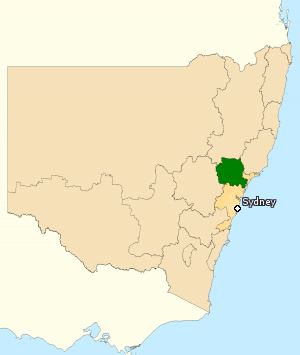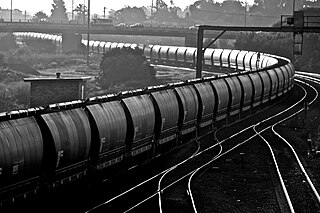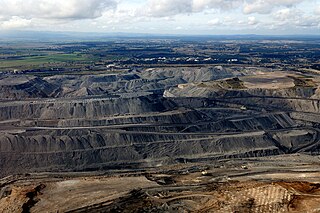
The Hunter River is a major river in New South Wales, Australia. The Hunter River rises in the Liverpool Range and flows generally south and then east, reaching the Tasman Sea at Newcastle, the second largest city in New South Wales and a major harbour port. Its lower reaches form an open and trained mature wave dominated barrier estuary.

Xstrata plc was an Anglo-Swiss multinational mining company headquartered in Zug, Switzerland and with its registered office in London, United Kingdom. It was a major producer of coal, copper, nickel, primary vanadium and zinc and the world's largest producer of ferrochrome. It had operations in 19 countries across Africa, Asia, Australasia, Europe, North America and South America.

The Division of Hunter is an Australian electoral division in the state of New South Wales. The division was proclaimed in 1900, and was one of the original 65 divisions to be contested at the first federal election. The division was named after Captain John Hunter, the second Governor of New South Wales. It covers rural, regional and suburban areas centered on the Hunter Region, including the towns of Singleton, Muswellbrook and Cessnock. It also extends into parts of Greater Newcastle, covering suburbs such as Cameron Park, Edgeworth, Toronto and Morisset.

Cerrejón is a large open-pit coal mine in Northern Colombia owned by Glencore. At Cerrejón, low-ash, low-sulphur bituminous coal from the Cerrejón Formation is excavated. At over 690 square kilometres (270 sq mi) the mine is one of the largest of its type, the largest in Latin America and the tenth biggest in the world. Cerrejón is divided into three sections, North Zone, Central Zone and South Zone. Total proven reserves are estimated at 503 megatonnes. In 2016, the mine produced 32,683,315 tonnes.

Bayswater Power Station is a bituminous (black) coal-powered thermal power station with four 660 megawatts (890,000 hp) Tokyo Shibaura Electric (Japan) steam driven turbo alternators for a combined capacity of 2,640 megawatts (3,540,000 hp). Commissioned between 1985 and 1986, the station is located 16 kilometres (10 mi) from Muswellbrook, and 28 km (17 mi) from Singleton in the Hunter Region of New South Wales, Australia.
Glencore plc is a Swiss multinational commodity trading and mining company with headquarters in Baar, Switzerland. Glencore's oil and gas head office is in London and its registered office is in Saint Helier, Jersey. The current company was created through a merger of Glencore with Xstrata on 2 May 2013. As of 2015, it ranked tenth in the Fortune Global 500 list of the world's largest companies. In the 2020 Forbes Global 2000, Glencore International was ranked as the 484th-largest public company in the world. As of July 2022, it is the world's largest commodity trader.

The Hunter Valley Coal Chain (HVCC) is the chain of coal delivery in New South Wales, Australia from coal mines in the Hunter Region to the Port of Newcastle and domestic coal-fired power stations in the Hunter Valley. The HVCC essentially follows the path of the Hunter River travelling south-east from the mining areas in the Hunter Valley to Newcastle.
Greenpeace Australia Pacific (GPAP) is the regional office of the global environmental organisation Greenpeace. Greenpeace Australia Pacific is one of Australia's largest environmental organisations.

Coal is mined in every state of Australia. The largest black coal resources occur in Queensland and New South Wales. About 70% of coal mined in Australia is exported, mostly to eastern Asia, and of the balance most is used in electricity generation. In 2019-20 Australia exported 390 Mt of coal and was the world's largest exporter of metallurgical coal and second largest exporter of thermal coal.
The Sandy Hollow–Gulgong railway line is a railway line in eastern New South Wales, Australia. The line forms a cross country connection from the Main North line in the Upper Hunter region to the Gwabegar line in the Central West region. The line is approximately 125 kilometres (78 mi) in length. From the Gwabegar line, trains can then ultimately reach the Main West line creating a circuitous bypass of Sydney for freight traffic heading between the west and north of New South Wales. The line was opened in 1985.
Environmental Defenders Office (EDO) is an Australian law centre that encourages and enables litigation, law reform, and community engagement on environmental issues. EDO formed in late 2019 with the merger of eight separate state and territory organisations into one national organisation. Topics of interest to EDO include: climate change, biodiversity, water, and healthy communities.

Bulga Coal Pty Limited is a coal-mining company based in Singleton, New South Wales, Australia. The company operates two mines Bulga Surface Operations and Beltana Longwall Mining which form the Bulga Coal Complex. The company is a joint venture between Oakbridge Pty Ltd and Nippon Oil Australia Pty Ltd. Bulga Coal currently produces approx 16 million tonnes of coal per year

The Wollangambe River, an Australian perennial river that is part of the Hawkesbury–Nepean catchment within the Sydney Basin, is located in the Greater Blue Mountains Area of New South Wales.
÷Some of the more notable coal companies in Australia are the following:
Westside Mine is a former coal mine located at Wakefield, New South Wales, Australia. The open cut mine was developed to provide coal for the Eraring Power Station. The mine started in 1992 and closed in February 2012 due to exhaustion of mineable reserves.
Quorrobolong is a small locality in the Hunter Region of New South Wales, Australia. It is located 11 km (7 mi) southeast of the town of Cessnock and is adjacent to Watagans National Park.

Tahmoor Colliery is an underground coal mine at Tahmoor in the Southern Highlands region of New South Wales, Australia. It operates in the Bulli coal seam. Most of the mine product is hard coking coal used for steel making. A small quantity of steaming blend coal used for power generation is also produced. Both products are exported to Europe and Asia.

Newcastle Government House is a heritage-listed former military post and official residence and now park and psychiatric hospital at 72 Watt Street, Newcastle, New South Wales, Australia. It is also known as Newcastle Government House and Domain, Newcastle Military Barracks & Hospital, Girls' Industrial School, Reformatory for Girls, Lunatic Asylum for Imbeciles, James Fletcher Hospital and Fletcher Park. It was added to the New South Wales State Heritage Register on 22 March 2011.
The Metropolitan Colliery is a coal mine located near Helensburgh, New South Wales owned by Peabody Energy. It was opened by in 1887 by the Cumberland Coal & Iron Mining Company. In 1965, the mine was purchased by Australian Iron & Steel. A proposed sale to South32 in 2016 was abandoned after the Australian Competition & Consumer Commission refused to approve it.
Torbane was a privately-owned village lying within the area now known as Capertee, in the Local Government Area of the City of Lithgow, within the Central West region of New South Wales, Australia. There was also another village, Airly, nearby. Both villages were associated with the mining of oil shale. The mine associated with Torbane was known as the New Hartley Mine. and that associated with Airly was known as the Genowlan Mine. There were retorts that produced crude shale oil at Torbane. Both Torbane and Airly are now ghost towns.










